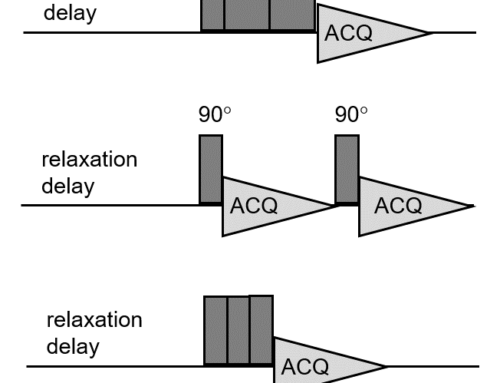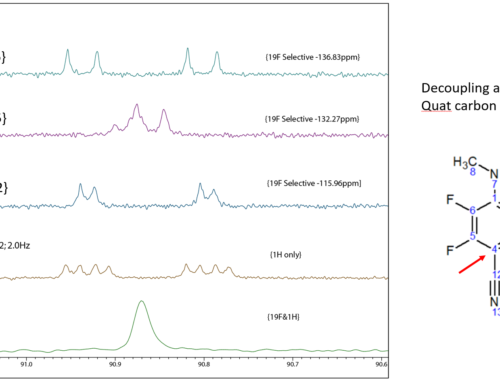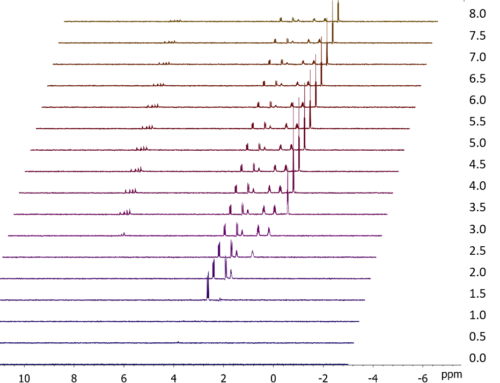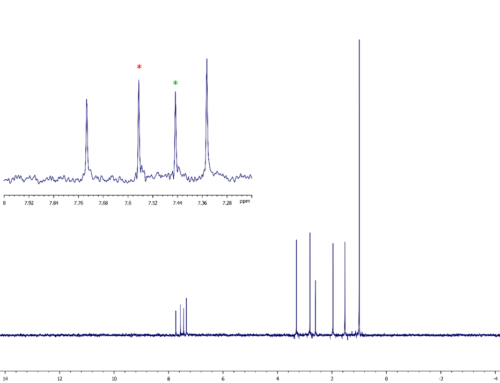In this post, I’m going to talk about how we can run one of the most popular pure shift experiments, Zangger-Sterk, in band-selective mode, and why this can be a useful alternative to running it in the more conventional “slice selective” mode.
Recently, I’ve been talking about ultra-selective excitation using the recently-published GEMSTONE method. One of the important aspects in getting GEMSTONE experiments to work well is setting the transmitter frequency (x_offset in Delta parlance) exactly on resonance with respect to the signal to be excited. However, reading the exact chemical shift of peak is often not possible from a standard proton spectrum. Consider, for example, the cluster of overlapped signals in the 1.8 ppm region of the proton spectrum of β-estradiol (Figure 1). Each peak in the cluster is a complex multiplet, which on its own would make it practically impossible to extract the precise chemical shift of each peak, but the problem is exacerbated by the fact that the peaks are overlapped with one another.

Figure 1. Proton spectrum of β-estradiol. The overlapped group of three peaks is shown in the inset.
The solution here is to collect a quick pure shift “scout” spectrum. In a pure shift experiment, homonuclear J-splittings are removed from the spectrum, giving a single line for each peak in the spectrum instead of the usual multiplet. It’s then a simple matter to read the chemical shifts directly from the pure shift spectrum.
To PSYCHE or not to PSYCHE?
There are a quite a number of different pure shift experiments that we could use for this purpose, so which should we use? One might be tempted to use the PSYCHE experiment because it’s quite robust and has decent sensitivity (for a pure shift experiment), but I’m going to suggest instead using the Zangger-Sterk (ZS) experiment. This also has the advantage that it uses the same RSNOB shaped pulse as the GEMSTONE experiments, so serves as a good check that the bandwidth of this pulse is set correctly (but more on that in my next post).
Zangger-Sterk pure shift experiment
Figure 2 shows the basic Zangger-Sterk pulse sequence. The boxed region shows the RSNOB shaped pulse and field gradient that sits under it.

Figure 2. Zangger-Sterk (ZS) pulse sequence
Figure 3 shows a quick ZS spectrum I collected on the β-estradiol sample.

Figure 3. ZS spectrum of β-estradiol. The spectrum was collected using 1 scan and 64 increments in 2 minutes.
If we look at the region of the spectrum shown in Figure 1 we can see that we have resolved singlet peaks instead of multiplets and it’s now easy to get the precise chemical shift of each signal.
Running Zangger-Sterk in band-selective mode
There is a simple parameter “trick” we can apply to the ZS experiment that can be very useful, particularly when doing a scout measurement or working with more dilute samples. The pulse sequence as shown in Figure 2 gives a full pure shift spectrum across the entire proton chemical shift range. For the purposes of our scout measurement, though, we don’t need the full spectrum, we just need the chemical shifts of our overlapped signals. Instead, we can run the ZS in band-selective mode, simply by switching off the gradient under the RSNOB shaped pulse and setting the transmitter frequency to somewhere in the middle of the signals we are looking at. In the Delta ZS experiment pureshift_1d_zs.jxp, this is done by setting the parameter grad_sl_ps_amp to 0 [T/m] (red box in Figure 4) and adjusting x_offset to somewhere in the middle of the signals of interest.

Figure 4. Converting the ZS experiment to run in band-selective mode. Setting the amplitude of the gradient in the red box will cause the experiment to be band-selective.
We can also cut down the measurement time significantly by reducing the number of increments (y_points). In many cases, 16 increments (combined with appropriate apodization) are more than enough to provide a suitable scout spectrum. Figure 5 shows the band-selective ZS spectrum of β-estradiol centred around 1.78 ppm. The spectrum was collected using 16 increments in less than a minute. As with the conventional ZS spectrum, we can easily read the chemical shifts of each signal.

Figure 5. Standard proton (bottom) and band-selective ZS spectrum (top) of β-estradiol centred at 1.78 ppm.
So by now you’re probably asking, why bother running the ZS in band-selective mode when the standard mode will provide the chemical shift information we want? The answer is sensitivity: compared to a standard proton spectrum, we pay a huge penalty in sensitivity (as much as two orders of magnitude) when we run the ZS in conventional mode. By contrast, band-selective ZS spectra show effectively full sensitivity and, actually, the signals frequently show greater intensity because of the removal of the peak multiplet structure. With more dilute samples, running a scout ZS pure shift experiment in conventional mode may require considerable signal averaging and take a long time to collect, so the band-selective approach is far preferable in these instances.
If you’d like to find out more about pure shift NMR experiments, or learn how JASON can help simplify your workflow, let us know!




